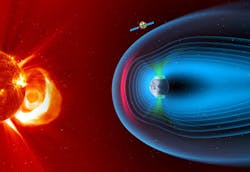ESA selects Airbus to produce SMILE satellite component
MADRID, Spain - Airbus has been selected by the European Space Agency to build the European component of the SMILE satellite (Solar wind Magnetosphere Ionosphere Link Explorer). SMILE will be the first joint satellite mission between the European Space Agency (ESA) and the Chinese Academy of Sciences (CAS), following on from the success of the Double Star / Tan Ce mission which flew between 2003 and 2008.
The objective of SMILE is to study and understand space weather. Specifically, it will look at the physics behind continuous interaction between particles in the solar wind and Earth's magnetosphere, the magnetic shield that protects the existence of life in our planet.
The mission is now entering a four year period of manufacturing, testing, and integration of the payload module and the platform. In launch configuration these two components will form a 3.15-m-high stack.
The spacecraft will have a mass of 2,200 kg and will travel in a highly elliptical orbit around the Earth. Its perigee will be at a distance of 5,000 km (from where it will download data to the Troll ground station in Antarctica and the CAS ground station in Sanya, China), while the apogee will be as far as 121,000 km (this is almost one third the distance to the Moon). At this vantage point the satellite will have a prolonged view of the Earth's northern polar regions, to enable the boundary of the Earth's magnetic field and the Northern Lights, or aurora borealis, to be imaged.
The payload module will be built at the Airbus site in Madrid, where the instruments will be integrated. The platform will be built in Shanghai. Both, the payload module and the platform will be integrated and tested at ESA’s European Space Research and Technology Centre facilities by a multinational team.
